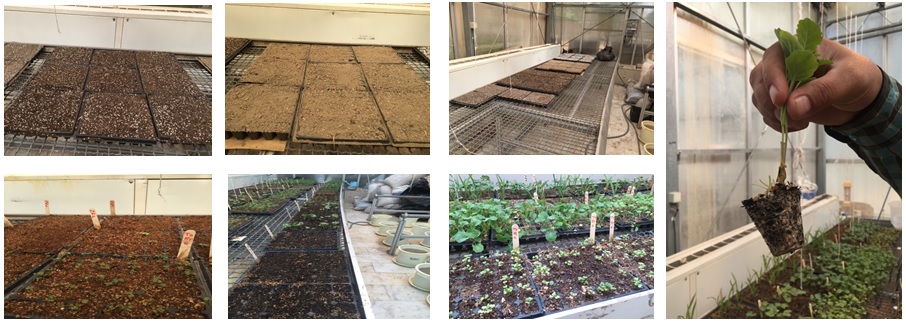Using different organic wastes as growing substrate for the production of crop seedlings - An exploratory study
- Soil and Water Research Institute, Agricultural Research Education and Extension Organization (AREEO), Karaj, Iran

Received: 2024-10-20
Revised: 2024-12-02
Accepted: 2025-01-01
Published in Issue 2025-06-01
Copyright (c) -1 Seyed Ali Ghaffari Nejad, Seyed Majid Mousavi (Author)

This work is licensed under a Creative Commons Attribution 4.0 International License.
How to Cite
PDF views: 192
Abstract
Purpose: This study was conducted to find a suitable growing substrate for the production of crops (corn, cotton, and canola) seedlings.
Method: This experiment was conducted as a completely randomized design with six treatments including different levels of organic wastes (peat moss, perlite, rotted cow manure, palm peat, vermicompost, sugarcane bagasse compost, tea waste compost) on the status of the production of corn, cotton and canola seedlings in the research greenhouse of the Soil and Water Research Institute, Karaj Iran in 2022.
Results: The results showed that the superior substrate for the production of corn and cotton seedlings is the substrate containing tea waste compost (shoot fresh weight 4.91 and 4.31gr respectively for corn and cotton). But the superior substrate for the production of canola seedlings was the substrate containing vermicompst (shoot fresh weight 5.56 gr). Although tea waste compost has a higher production cost than other treatments, it causes seedlings to ripen up to one week early, and this partially justifies the high cost of its production.
Conclusion: It is concluded that the substrates containing tea compost were more effective than the other substrates for the production of corn and cotton seedlings, while the substrates containing vermicompost were superior to the other substrates for the production of canola seedlings. However, more research on its application for different crops and under various conditions is needed to approve the results of this study.
Research Highlights
- A relatively higher shoot dry weight of corn and cotton seedlings is produced in tea waste compost compared to other substrates.
- A relatively higher shoot dry weight of canola seedlings is produced in vermicompost compared to other substrates.
- The most suitable substrate for the production of corn and cotton seedlings is the substrate containing tea waste compost.
- The most suitable substrate for the production of canola seedlings is the substrate containing vermicompost.
- Although tea waste compost has a higher production cost than other treatments, it causes seedlings to ripen up to one week early, and this partially justifies the high cost of its production.
Keywords
- Growing substrate,
- Seedlings cultivation,
- Cotton,
- Corn,
- Canola
References
- Bachman GR, Metzger JD (2008) Growth of bedding plants in commercial potting substrate amended with vermicompost. Bioresour Technol 99(8): 3155-3161. https://doi.org/10.1016/j.biortech.2007.05.069
- Basirat M, Davoudi MH (2020) Assessment of different Date Palm based mixes for soilless culture. J Solid Waste Technol Manag 46(3): 314-320. https://doi.org/10.5276/JSWTM/2020.314
- Basirat M, Mousavi SM, Dehghani F, Davoudi MH (2022) Exploratory research on the adoption of new organic wastes for production of greenhouse cucumber in soilless culture. Waste Biomass Valori 14: 2367–2374. https://doi.org/10.1007/s12649-022-01995-4
- Bower C, Reitemeier R, Fireman M (1952) Exchangeable cation analysis of saline and alkali soils. Soil Sci 73(4): 251-262. https://doi.org/10.1097/00010694-195204000-00001
- Dai J, Dong H (2014) Intensive cotton farming technologies in China: Achievements, challenges and countermeasures. Field Crops Res 155: 99-110. https://doi.org/10.1016/j.fcr.2013.09.017
- Mahboob Khomami A (2010) The effect of sawdust vermicompost in pot culture on nutrition and growth of Dieffenbachia plant. Seed and Plant Production 2(4): 435-444. https://doi.org/10.22092/SPPJ.2017.110418 (In Persian).
- Omidi J, Hatemzadeh A, Mahboob Khamani A (2019) Use of peanut shell compost in growth media and its effect on the physical and chemical properties of soil. J Soil Res. 34(2): 308-291. https://doi.org/10.22092/IJSR.2020.122640 (In Persian).
- Pascual JA, Ceglie F, Tuzel Y, Koller M, Koren A, Hitchings R, Tittarelli F (2018) Organic substrate for transplant production in organic nurseries. A review. Agron Sustain Dev 38: 1-23. https://doi.org/10.1007/s13593-018-0508-4
- Rivera B, Quej VH, Gutiérrez R, Andrade JL, Carrillo E, González V, Villarreal EC (2022) Use of organic substrates on the quality of watermelon seedlings. Hortic Bras 40(3): 261-267. https://doi.org/10.1590/s0102-0536-20220303
- Sparks DL, Page A, Helmke P, Loeppert R, Soltanpour P, Tabatabai M, Johnston C, Sumner M (1996) Methods of soil analysis. soil science society of America, Madison. Online ISBN: 9780891188667. https://doi.org/10.2136/sssabookser5.3
- Tüzel Y, Öztekin G, hakkı Tüzel İ, Duyar H (2020) Growing media in organic seedling production. Ege Üniversitesi Ziraat Fakültesi Dergisi 57(4): 603-610. https://doi.org/10.20289/zfdergi.755975

 10.57647/ijrowa-282g-fm56
10.57647/ijrowa-282g-fm56












